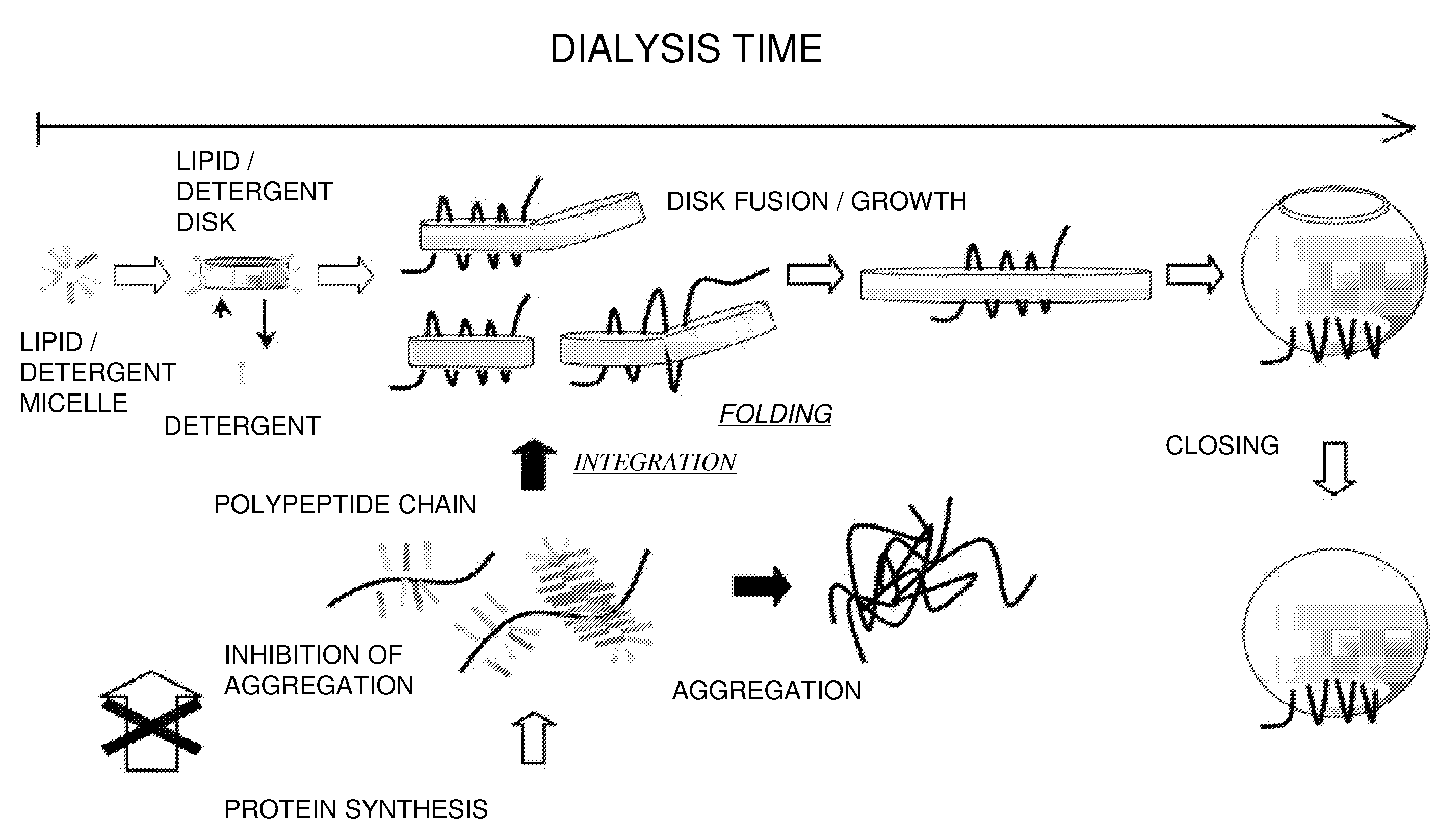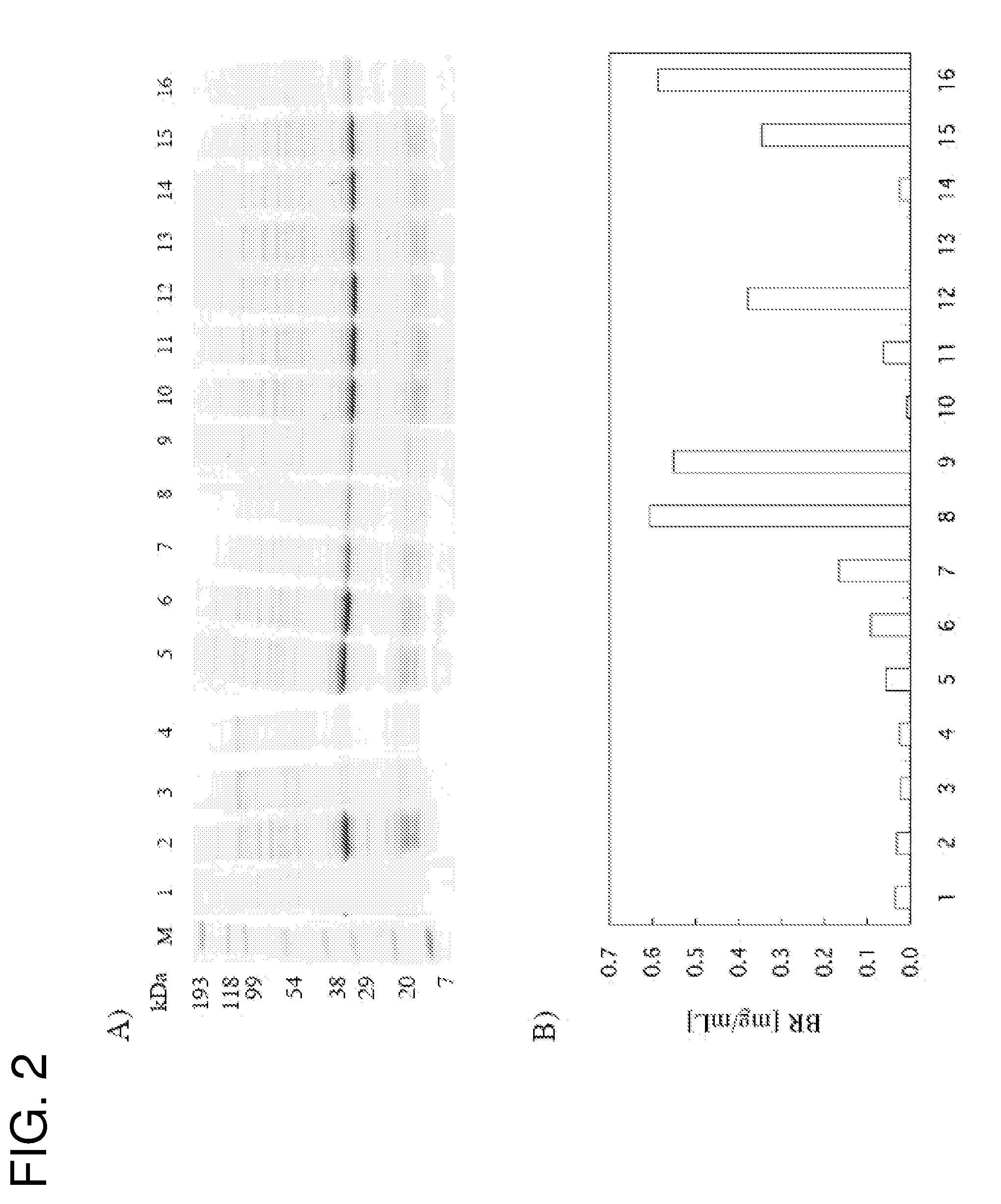Method for producing a membrane protein
a membrane protein and protein technology, applied in the field of membrane protein production, can solve the problems that the method of membrane protein as disclosed in the above mentioned documents cannot provide sufficient yield and reproducibility, and achieve the effect of protein folding
- Summary
- Abstract
- Description
- Claims
- Application Information
AI Technical Summary
Benefits of technology
Problems solved by technology
Method used
Image
Examples
example 1
Functional Expression of Bacteriorhodopsin (BR) Derived from Extreme Halophile Halobacterium salinarum in Cell Free System
[0048]BR is a light-driven proton pump which is a seven-transmembrane α-helical membrane protein. BR has all-trans retinal as a chromophore, covalently binds to a lysine residue at position 216, and exhibits maximum absorbance at the wavelength of around 570 nm. When absorbing the light of around 570 nm, the all-trans retinal is photoisomerized to 13-cis-retinal. Along with the photoisomerization, the conformation of BR is changed and a reaction occurs which BR is returned to its initial state via its various photochemical reaction intermediates temperature-dependently. During the serial process, a proton is transported from the cytoplasmic side to the extracellular side.
1) Preparation of a BR Synthetic Plasmid
[0049]A synthetic plasmid was prepared by amplifying a fragment comprising a native His tag having a recognition site of TEV (Tobacco Etch Virus) (MKDHLIHN...
example 2
Functional Expression of E. coli-Derived Water Channel (AQPZ) in a Cell Free System
[0064]AQPZ is a six-transmembrane α-helical membrane protein, and serves as a water channel. It is known that AQPZ forms a very stable tetramer.
1) Preparation of AQPZ Synthetic Plasmid
[0065]A synthetic plasmid was prepared by amplifying a fragment comprising a native His tag having a recognition site of TEV (Tobacco Etch Virus) (MKDHLIHNVHKEEHAHAHNKDYDIPTTENLYFQGSSG SSG: SEQ ID NO.:1), T7 promoter and T7 terminator by using 2-step PCR, and incorporating the fragment into a pCR2.1 vector. PCR was performed using 5′-primer; 5′-ccagcggctcctcgggaatgttcagaaaattagc-3′ (SEQ ID NO.: 5), 3′-primer; 5′-gggcggggatcaatcaatcattaatcacgcttttcca gca-3′ (SEQ ID NO.: 6) and E. coli colony as a template, and a gene encoding the full-length AQPZ was amplified. Subsequently, with the first PCR product used as a template, second PCR was performed using two chemical synthetic double stranded DNA fragments (5′ fragment encod...
example 3
Functional Expression of Enterococcus hirae-Derived V Type ATPase K Subunit (NtpK) in a Cell Free System
[0071]Enterococcus hirae-derived V type ATPase is a sodium ion pump acting by the energy of ATP hydrolysis, and a supermolecule complex comprising 9 subunits. Among them, K subunit (NtpK) is a 4-transmembrane α-helical membrane protein, constitutes a rotor portion which exists in cell membrane, and forms a ring-shaped decamer.
1) Preparation of NtpK Synthetic Plasmid
[0072]A synthetic plasmid was prepared by amplifying a fragment comprising histidine tag having a recognition site of TEV (Tobacco Etch Virus) protease, T7 promoter and T7 terminator by using 2-step PCR, and incorporating the fragment into pCR2.1 vector. A complete synthetic gene as optimized for E. coli expression was used as a template. The synthetic gene was provided from Dr. MURATA Takeshi in Kyoto Univ. PCR was performed using 5′-primer; 5′-ccagcggctcctcgggaatgatggattacctgat-3′ (SEQ ID NO.: 7) and 3′-primer; 5′-cct...
PUM
| Property | Measurement | Unit |
|---|---|---|
| Concentration | aaaaa | aaaaa |
| Concentration | aaaaa | aaaaa |
| Concentration | aaaaa | aaaaa |
Abstract
Description
Claims
Application Information
 Login to View More
Login to View More - R&D
- Intellectual Property
- Life Sciences
- Materials
- Tech Scout
- Unparalleled Data Quality
- Higher Quality Content
- 60% Fewer Hallucinations
Browse by: Latest US Patents, China's latest patents, Technical Efficacy Thesaurus, Application Domain, Technology Topic, Popular Technical Reports.
© 2025 PatSnap. All rights reserved.Legal|Privacy policy|Modern Slavery Act Transparency Statement|Sitemap|About US| Contact US: help@patsnap.com



